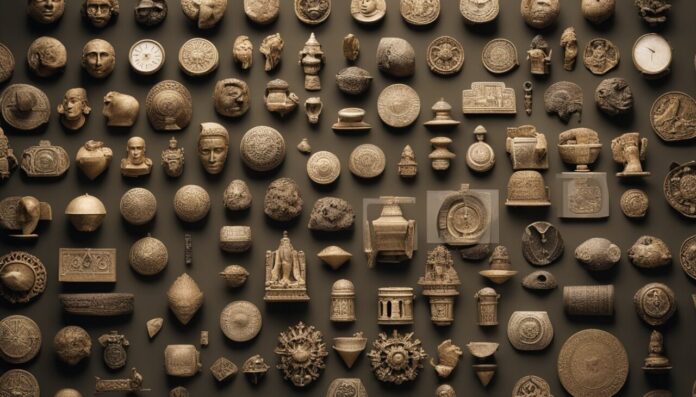
Artifacts are objects that have been created or modified by humans, often with a cultural or historical significance. They can be made of various materials such as stone, bone, metal, or clay and can range in size from tiny fragments to monumental structures.
The study of artifacts is an important aspect of archaeology, providing insights into the lives, beliefs, and practices of past societies.
And so, the oldest known artifact is the Lomekwi stone tools. It is estimated that these tools are 3.3 million years old.
The Lomekwi stone tools were discovered in Kenya and were used by early hominins for cutting and pounding.
Another ancient artifact is the Venus of Hohle Fels, which is about 40,000 years old and is the oldest known portrayal of a human being. This figurine is made of mammoth ivory and depicts a woman’s body with exaggerated sexual features.
These are just a few examples of the oldest artifacts in the world.
So, let’s explore the full list.
Related:
Top 10 Oldest Artifacts – Summary Table
| Artifact | Age (Years) | Location | Material | Description |
| Lion-Man of Hohlenstein-Stadel | 35,000-40,000 | Germany | Mammoth Ivory | Human figure with a lion’s head, 31 cm tall and with intricate design. |
| Venus of Hohle Fels | 35,000-40,000 | Germany | Mammoth Ivory | Venus figurine represents a woman, 6 cm tall, with exaggerated features. It is the earliest known depiction of a human in prehistoric art. |
| El Castillo Cave Paintings | At least 40,800 | Spain | Cave paintings | Oldest known cave art depicting animals, hand stencils, and geometric shapes. Shows early humans’ sophisticated understanding of art. |
| Sulawesi Cave Art | At least 45,500 | Sulawesi, Indonesia | Cave paintings | Paintings of animals and abstract designs. Oldest known representational art. Demonstrates sophisticated techniques in pigment application. |
| Venus of Willendorf | Approximately 25,000 | Austria | Limestone | Small female figurine, 11.1 cm tall, with exaggerated features. The purpose is unknown, possibly a fertility symbol. |
| Venus of Tan-Tan | Supposedly 500,000 | Morocco | Quartzite | Small, elongated figurine, 6 cm in length. Controversial interpretation as a symbolic or ritual object. |
| Oldowan Tools | 2.6 million – 1.7 million | Various locations (mostly Africa) | Stone | Stone tools made by early hominins, chopper being the most common tool. Used for various tasks. |
| Acheulean Hand Axes | 1.76 million – 100,000 | Various locations (Africa, Europe, Indian subcontinent) | Chipped stone | A large, formally-shaped working tool made by early humans during the Acheulean period. Versatile and used for cutting, chopping, and scraping. |
| Blombos Cave Ochre | Approximately 73,000 | South Africa | Ochre | Ochre piece with cross-hatched pattern, earliest known human drawing. Provides evidence of early human cognitive ability. |
| Lomekwi Stone Tools | Approximately 3.3 million | Kenya | Volcanic rock | Oldest known evidence of stone tools, challenging previous beliefs of human history. Made by early humans using the knapping technique. |
Lion-Man of Hohlenstein-Stadel
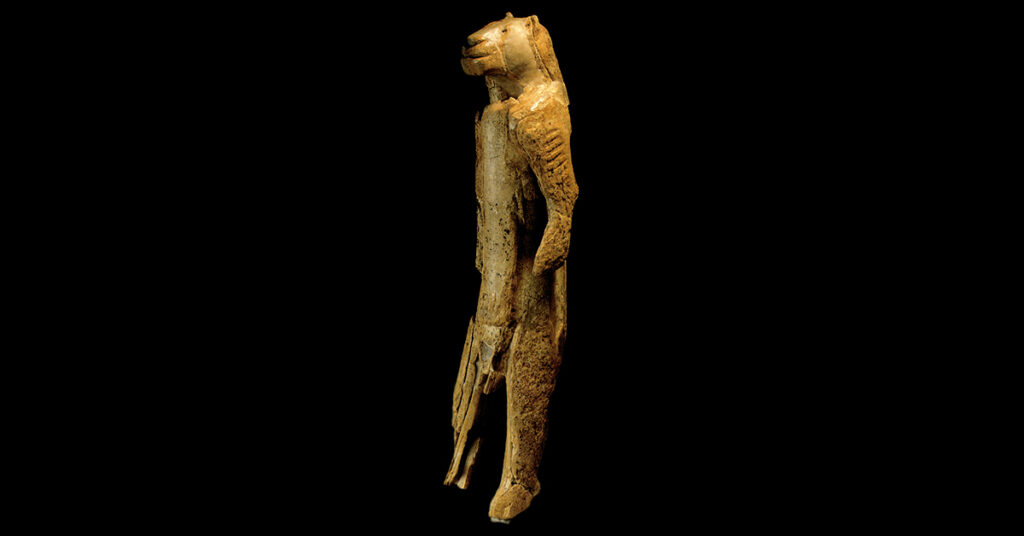
The Lion-Man of Hohlenstein-Stadel, also known as the Lion-Human, is a prehistoric sculpture that was discovered in the Hohlenstein-Stadel cave in the Swabian Jura of southwestern Germany. It is one of the oldest known sculptures portraying a human-animal hybrid and is considered a significant archaeological find.
Dating back to the Upper Paleolithic period, approximately 40,000 years ago, the Lion-Man is carved from a mammoth tusk and stands about 12.2 inches (31.1 cm) tall. The sculpture represents a figure with a human body and the head of a lion or big cat.
The Lion-Man of Hohlenstein-Stadel is thought to be associated with early forms of spirituality or shamanistic beliefs. It is considered a witness to the creative abilities and symbolic thinking of our ancient ancestors during a time when humans were developing more complex social structures and engaging in symbolic expression through art.
The Lion-Man is currently exhibited in Germany in Museum Ulm.
Venus of Hohle Fels

The Venus of Hohle Fels is an ancient figurine that was discovered in the Hohle Fels cave in the Swabian Jura of southwestern Germany. It is one of the oldest known examples of a female figurine, and it dates back to the Upper Paleolithic period, making it around 35,000 to 40,000 years old.
Carved from mammoth ivory, the Venus of Hohle Fels is a small, stylized representation of a woman with exaggerated features. The figurine is characterized by a pronounced emphasis on the female reproductive organs, breasts, and buttocks, while the limbs and facial features are minimally detailed. The overstated emphasis on fertility-related attributes suggests that the Venus of Hohle Fels may have had a symbolic or ritualistic purpose associated with fertility, childbirth, or other aspects of early human spirituality.
The Venus of Hohle Fels is part of a group of similar artifacts found in various archaeological sites in Europe, collectively known as “Venus figurines.” These figurines are considered important cultural artifacts that provide insights into the symbolic and artistic expressions of Paleolithic societies.
The Venus of Hole Fels is currently housed at the Prehistoric Museum of Blaubeuren in Germany.
El Castillo Cave Paintings
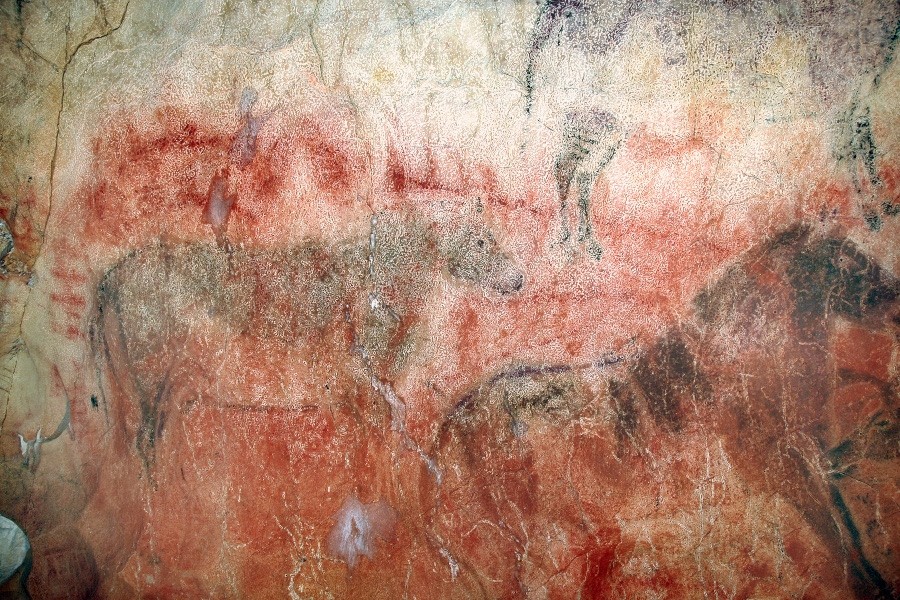
El Castillo Cave Paintings is a collection of prehistoric art discovered in the Cave of El Castillo in Cantabria, Spain. The paintings are believed to be at least 40,800 years old, making them one of the oldest known cave art in the world. The cave was discovered in 1903 by Hermilio Alcalde del Río, a Spanish archaeologist.
The paintings are located in the “Gallery of the Hands” and include a panel of abstract signs and hand stencils.
The El Castillo Cave Paintings are significant because they provide insight into the lives of early humans. The paintings depict animals such as bison, horses, and deer, as well as handprints and geometric shapes.
The use of color and shading in the paintings suggests that early humans had a sophisticated understanding of art and were able to create realistic depictions of the world around them.
Sulawesi Cave Art
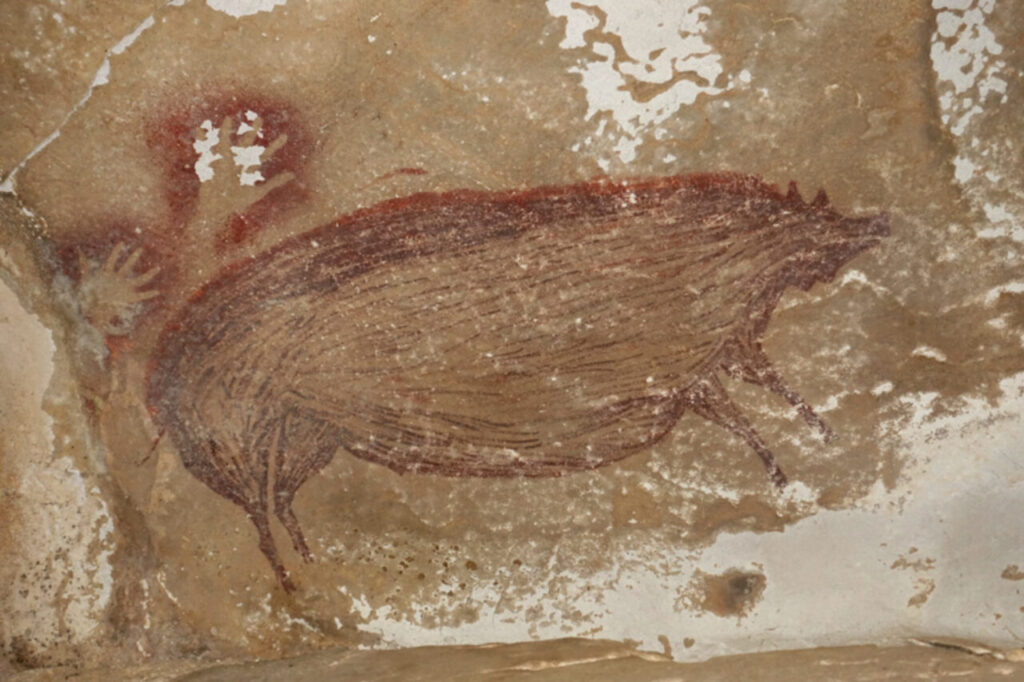
One of the oldest and most significant examples of cave art in the world was discovered in Sulawesi, Indonesia. The art was found in a series of limestone caves located in the southern part of the island. The paintings depict a variety of animals, including pigs, deer, and buffalo, as well as hand stencils and abstract designs.
The oldest of these paintings is a figurative depiction of a Sulawesi warty pig, which has been dated to at least 45,500 years old. This makes it the oldest known examples of representational art in the world. The pig is painted in red ochre and is located in the Leang Bulu’ Sipong 4 cave.
Other notable examples of Sulawesi cave art include a painting of a buffalo being hunted by part-human, part-animal figures, which has been dated to 44,000 years old. This painting is located in the Lubang Jeriji Saléh cave.
The Sulawesi cave art is significant not only for its age but also for the sophistication of the techniques used. The artists used a variety of pigments, including red and yellow ochre, and applied them using a range of techniques, such as blowing the pigment through reeds or using their fingers.
Venus of Willendorf

The Venus of Willendorf is one of the oldest and most famous artifacts in the world. It is a small, portable human figurine that was found in 1908 at Willendorf, Austria. The figurine is made of limestone and is estimated to be around 25,000 years old.
The Venus of Willendorf is only 11.1 centimeters tall and is characterized by its inflated features, including large breasts, hips, and thighs. The figure’s head is also disproportionately small, with no facial features except for a small indentation where the face should be.
The purpose of the Venus of Willendorf is still unknown, but it is believed to be a fertility symbol.
Venus of Tan-Tan
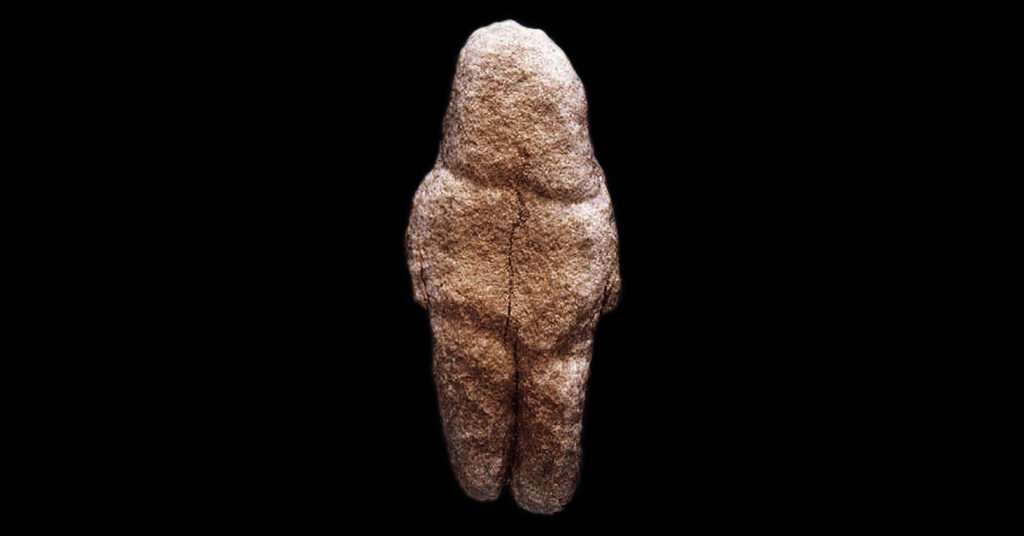
The Venus of Tan-Tan is a figurine that was discovered in Morocco in 1999. It was found by Lutz Fiedler, a German archaeologist, in the Haua Fteah cave in the southwestern part of Morocco. The artifact is supposedly about 500,000 years old!
The Venus of Tan-Tan is a small, elongated object that measures about 6 centimeters in length, 2.6 centimeters in width, and 1.2 centimeters in thickness. It weighs about 10 grams and is roughly the size of a human thumb. The figurine has a rounded base and a pointed top, and its shape has led some to suggest that it may have been used as a tool or a weapon.
The name “Venus” was given to the artifact by its discoverer, Lutz Fiedler, who noted its similarity to other prehistoric figurines that were found in Europe and were commonly referred to as “Venus figurines”.
However, the interpretation of the Venus of Tan-Tan as a representation of a human form is highly debated among scholars. Some argue that it may have been a naturally occurring rock formation that was potentially modified by early hominins. In contrast, others believe that it was intentionally crafted as a symbolic or ritual object.
Oldowan Tools

Oldowan tools are a type of stone tool associated with an archaeological tradition named after the Olduvai Gorge in Tanzania, where these tools were first discovered. The Oldowan tool tradition is one of the earliest stone tool industries and is associated with the early part of the Paleolithic period.
These tools date back to approximately 2.6 million to 1.7 million years ago and are attributed to some of the earliest hominins, possibly including Homo habilis (handy man). Oldowan tools are characterized by their simple and unmodified nature. They typically consist of sharp-edged flakes or choppers that were created through the process of knapping—breaking rocks to produce sharp-edged tools. The primary raw material for Oldowan tools was usually volcanic rocks or quartz.
Oldowan tools served a variety of purposes, including butchering animals, processing plants, and possibly other activities related to daily survival. While they lack the sophistication of later stone tool industries, the Oldowan tools represent a vital step in the development of technology and the use of tools by early hominins.
Acheulean Hand Axes

One of the oldest artifacts in the world is the Acheulean hand axe. These hand axes were created by early humans during the Acheulean period, which lasted from 1.76 million years ago to about 100,000 years ago. The hand axes were used for a variety of tasks, such as cutting, chopping, and scraping.
Acheulean hand axes are large, chipped stone objects that represent the oldest, most common, and longest-used formally-shaped working tool ever made by human beings. They were made by chipping away at a stone until it had the desired shape and size. The hand axes were often made from flint, which is a hard, durable stone that was readily available in many parts of the world.
The Acheulean hand axe is proof of the ingenuity and resourcefulness of early humans. Despite the limited technology available to them, they were able to create a tool that was effective and multipurpose.
Blombos Cave Ochre
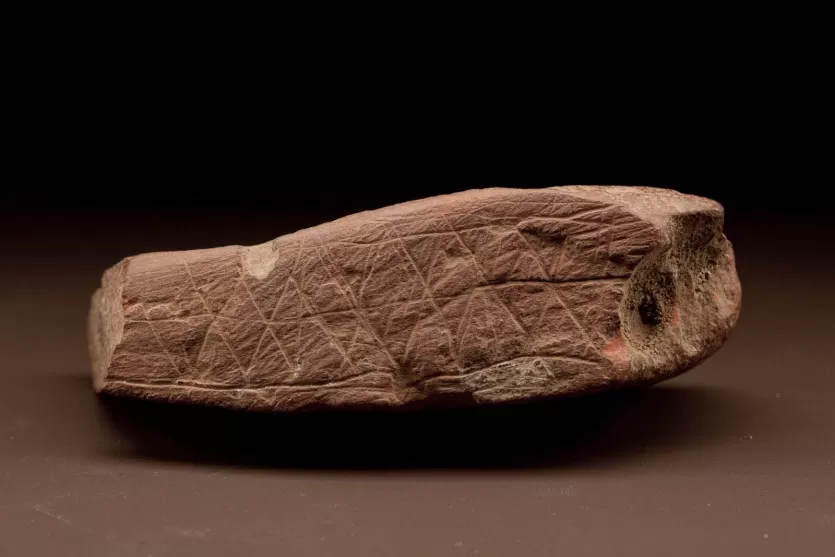
Blombos Cave in South Africa is home to some of the oldest artifacts in the world. One of the most significant finds from the cave is a piece of ochre with a cross-hatched pattern drawn on it. The drawing is believed to be the earliest known drawing done by a human in the world. The stone fragment dates back approximately 73,000 years.
The cross-hatched pattern was drawn with an ochre crayon on a ground silcrete flake recovered from the Middle Stone Age levels at Blombos Cave. The discovery of the ochre piece is significant because it provides evidence that early humans had the cognitive ability to create abstract designs and possibly even communicate through art.
The ochre piece is just one of many significant finds from Blombos Cave. The cave has also yielded beads covered in red ochre, engraved ochre fragments, and a variety of stone tools.
For example:
| Artifact | Age (years) |
| Ochre piece with cross-hatched pattern | Approximately 73,000 |
| Engraved ochre fragments | Approximately 100,000 |
| Stone tools | Approximately 100,000 |
| Beads covered in red ochre | Approximately 75,000 |
Lomekwi Stone Tools

The Lomekwi Stone Tools are a collection of ancient stone tools found at the Lomekwi 3 excavation site in Kenya. These tools are believed to be the oldest known evidence of stone tools, dating back approximately 3.3 million years ago.
The discovery of these tools was made by a team of scientists from Stony Brook University and the Max Planck Institute for Evolutionary Anthropology. The researchers found over 149 artifacts, including cores, flakes, and anvils, which were used to make other stone tools.
The Lomekwi Stone Tools are significant because they provide evidence of early human tool-making and suggest that our ancestors were capable of making and using tools much earlier than previously thought. The discovery also challenges the long-held belief that the first stone tools were made by the genus Homo, which appeared on the scene around 2.8 million years ago.
The Lomekwi Stone Tools are made from volcanic rock and were likely used for chopping and cutting. The tools were made using a technique called knapping, which involves striking a stone with another hard object to create a sharp edge.
Conclusion

The oldest artifacts in the world are a testimony to the ingenuity and resourcefulness of our ancestors. From stone tools to sculptures, these artifacts offer an interesting view of early humans and their lives.
The oldest artifact on the list is currently the Lomekwi stone tools, however, scientist, researchers, and anthropologists are constantly finding new clues.
Therefore, potentially, they’ll find something even older. Or perhaps they’ll discover some tools and clues that completely contradict existing knowledge of the history of Homo sapiens.
We’ll see, but certainly every new finding in anthropology is a rather exciting one.
For example, Göbekli Tepe was first examined—and dismissed—by the University of Chicago and Istanbul University anthropologists in the 1960s.
Then, only in recent years, based on its advanced architecture, it has become an accepted opinion that some parts of history need to be reconsidered or revised.
The same will happen with new artifact findings.
Hopefully, they will not be kept secret from the wider society.
Knowing our history enables us to better comprehend our future!
Frequently Asked Questions
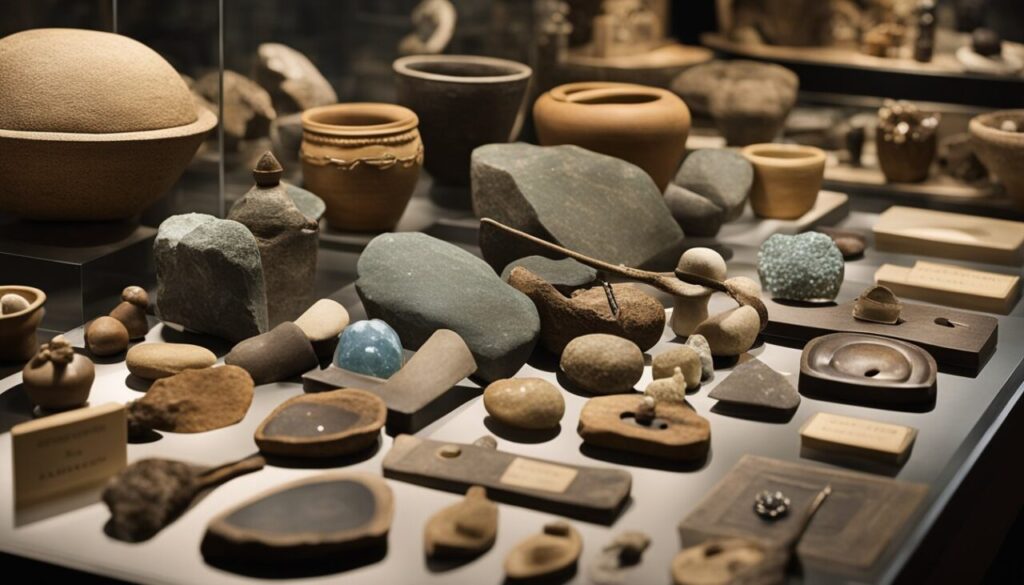
How do archaeologists measure the age of an artefact?
Archaeologists use various methods to determine the age of artifacts. Stratigraphy involves analyzing layers of sediment, while radiocarbon dating estimates age based on carbon-14 decay. Luminescence dating measures trapped electrons in minerals, dendrochronology uses tree rings, and thermoluminescence dating focuses on heated minerals. Potassium-argon dating is used for volcanic materials. These techniques help establish chronological sequences.
Which artifact holds the record as the oldest discovered on Earth?
The oldest artifact discovered on Earth is the Lomekwi stone tools, which were discovered in 2015 and are estimated to be around 3.3 million years old. These tools were discovered in Kenya and are believed to have been used by early hominins for chopping and cutting.
What are some examples of ancient artifacts that are still somehow a mystery for historians?
There are many ancient artifacts that still puzzle historians today, such as the Antikythera mechanism, which is an ancient Greek device that was used to predict astronomical positions and eclipses. Another example is the Nazca Lines, which are a series of large geoglyphs located in the Nazca Desert in Peru. The purpose of these lines is still unknown.
Which artifact is considered the oldest relic related to Jesus Christ?
The Shroud of Turin is considered the oldest relic related to Jesus Christ. This piece of cloth is believed to have been used to wrap the body of Jesus after his crucifixion and is thought to date back to around the 1st century CE.
What is recognized as the earliest human-made artifact discovered in North America?
Stone scraping tools discovered recently (in 2013), represent the oldest artifacts found in North America. It is estimated that those tools are more than 18000 years old.




















